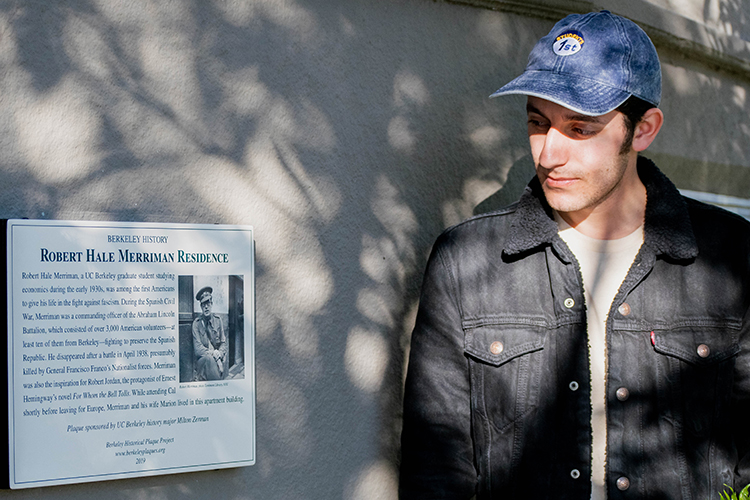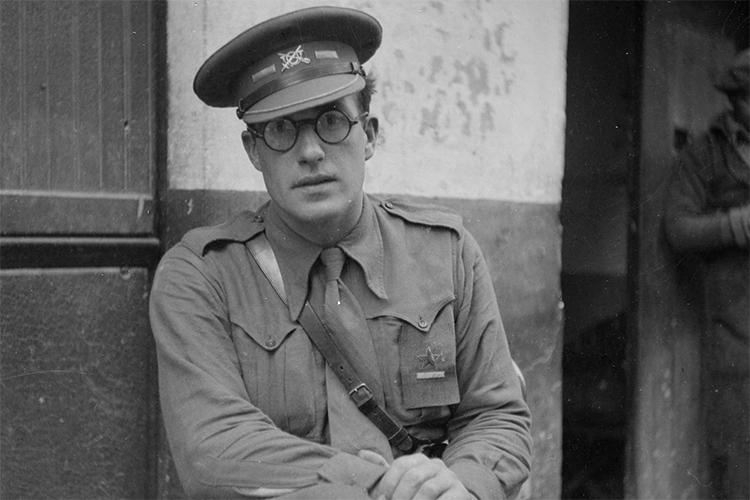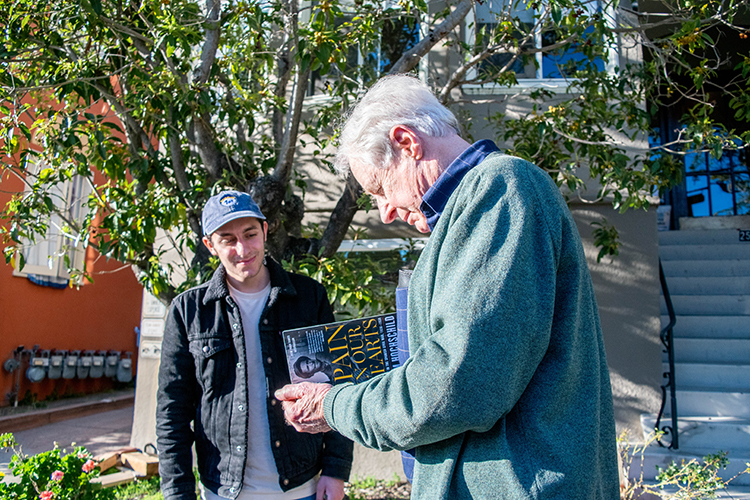Made of honor: History major secures plaque for Spanish Civil War hero
Historical marker now shows former home of one of Berkeley's "bravest" graduate students
February 12, 2020

Student Milton Zerman checks out the historical plaque installed on a Virginia Street apartment building in Berkeley to honor 1930s UC Berkeley Ph.D. student and Spanish Civil War hero Robert Merriman. The marker was Zerman’s idea, and he hopes the campus will similarly recognize all the Berkeley students who volunteered for that war. (UC Berkeley photo by Irene Yi)
Robert Merriman, a UC Berkeley Ph.D. student in the 1930s, was “the most popular of my generation of graduate students at Berkeley. Later, he was to show himself the bravest,” famous economist, writer and Berkeley alumnus John Kenneth Galbraith once said of his classmate.
A plaque newly installed on a Berkeley apartment building at 2517 Virginia Street will help passersby know why.
Berkeley history major Milton Zerman launched a project last summer to create a historic marker for Merriman, who died at age 28 in the 1936-1939 Spanish Civil War. Combat commander of the Abraham Lincoln Battalion, he was one of the highest-ranking American volunteers defending the democratically-elected Spanish government against rebels backed by Nazi Germany and Fascist Italy.
Zerman says he thinks Merriman would be proud of those who stop to read the plaque on Berkeley’s north side, near campus, and wind up achieving “a level of understanding and awareness … of the battalion’s cause.” He also hopes those who read about Merriman will be inspired to learn about the 2,800 U.S. citizens who volunteered during the Spanish Civil War.
At least 10 Berkeley students from diverse academic fields and racial backgrounds voluntarily fought in that war at a time when American public sentiment favored maintaining strict neutrality in European conflicts.
Berkeley journalism lecturer Adam Hochschild, whose book, Spain in Our Hearts: Americans in the Spanish Civil War, 1936-1939, sparked Zerman’s interest in honoring Merriman — Zerman read it in his “The History of Fascism” class — said he’s “all the more glad to see people like Milton become active at this historical moment, when fascist-like and ultra-nationalist and racist movements are on the rise in so many countries around the world.”

Former UC Berkeley Ph.D. student Robert Hale Merriman joined the volunteer International Brigades in 1936 to defend the democratically-elected Spanish government. He is believed to either have died in battle or to have been executed by the right-wing forces of Gen. Francisco Franco on April 2, 1938, in Corbera d’Ebre, Spain. His body was never found. (Photo courtesy of the Abraham Lincoln Brigade Archives)
Zerman had no trouble raising $1,000 to pay for the plaque when he held a GoFundMe effort.
“Some donors were classmates, some were friends,” he said, “and some were simply people who had heard about the project online.” Zerman got help from volunteers at the Berkeley Historical Plaque Project, and one of them recently installed the modest plaque on the street-facing façade of the building where Merriman once lived with his wife, Marion.
With the installation complete, Zerman now plans to gather information on the other Berkeley students, as well as non-student Berkeley residents, who fought in the Spanish Civil War.
“A few of their descendants have already reached out to me,” he said, “One, a Berkeley grad himself, said that tales of his father’s exploits in Spain motivated him to take part in the legendary Free Speech Movement.”
Ultimately, Zerman hopes the campus will create a page on its website about the students who fought in the Spanish Civil War and consider adding a memorial on campus “that students of all political stripes could get excited about, as it will be a symbol of how and when activism can merge with patriotic duty.”

Zerman and lecturer Adam Hochschild from the Graduate School of Journalism recently visited Robert Merriman’s plaque. Hochschild’s book, Spain in Our Hearts: Americans in the Spanish Civil War, 1936-1939, was required reading in “The History of Fascism,” a summer course where Zerman learned about Merriman. (UC Berkeley photo by Irene Yi)
Added Hochschild, “On our campus we honor Cal’s World War II veterans in Memorial Glade and elsewhere. Why shouldn’t we also honor those from Cal who, in Spain, fought what was really the first battle of that war? Where else, in 1937 and 1938, were Americans in uniform being bombed and shot at by the forces of Hitler and Mussolini?”
Zerman’s work on a historical marker for Merriman also led him to help the Berkeley Historical Plaque Project organize and consolidate its information on Berkeley historical sites so that the Bancroft Library can archive and preserve it.
And Merriman’s foreign service, and that of Berkeley students and alumni engaged in many volunteer efforts overseas, have given Zerman another idea: “My long-term goal is to attend law school, but I am seriously considering some form of foreign service or volunteer work abroad beforehand.”